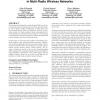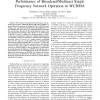185 search results - page 28 / 37 » On the Capacity of Non-Coherent Network Coding |
IJNSEC
2006
13 years 7 months ago
2006
Enhanced network services often involve preferential allocation of resources such as transmission capacity ("bandwidth") and buffer space to packets belonging to certain...
MMSEC
2006
ACM
14 years 1 months ago
2006
ACM
Two different approaches for constructing a steganographic channel in an IEEE 802.11 (WLAN) network are introduced in this paper. First test results on the reliability, undetectab...
MOBIQUITOUS
2008
IEEE
14 years 1 months ago
2008
IEEE
Multi-radio (multi-interface, multi-channel) 802.11 and sensor networks have been proposed to increase network capacity and to reduce energy consumption, to name only a few of the...
VTC
2008
IEEE
14 years 1 months ago
2008
IEEE
Abstract—We evaluate the system-level performance and potential capacity gain of MBSFN (Multicast/Broadcast Single Frequency Network) operation in Wideband CDMA (WCDMA) and compa...
GLOBECOM
2009
IEEE
14 years 2 months ago
2009
IEEE
—A key technology in cooperative communications is distributed space-time coding (DSTC) which achieves spatial diversity gain from multiple relays. A novel DSTC, called randomize...


